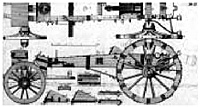 Artillery of the Napoleonic Wars by Kevin
Kiley is a work of tremendous scope and the
result of a huge amount of research. As a
former artillery officer himself, Kiley is in a
unique position from which to explain and
assess the development and use of artillery
during the period. He explains how his
interest in the subject originally started and
outlines how this book came to be written.
Artillery of the Napoleonic Wars by Kevin
Kiley is a work of tremendous scope and the
result of a huge amount of research. As a
former artillery officer himself, Kiley is in a
unique position from which to explain and
assess the development and use of artillery
during the period. He explains how his
interest in the subject originally started and
outlines how this book came to be written.
“My interest in artillery was sparked at the age of eight when my parents took me to Gettysburg for the first time. The number and type of guns, together with limbers and caissons, fascinated me and began a life-long study of field artillery. As my study continued and matured, Captain Hubert Dilger, the famous Baden horse artilleryman who won the Medal of Honor at Chancellorsville in the American Civil War, and again distin-guished himself at Gettysburg, became a particular favorite of mine, as did the French artillerymen Senarmont, Eble, and Drouot.
As an avid collector of toy and model soldiers, artillery has always had a prominent part in my collection, especially that of the Grande Armée and the Continental Army of the American Revolution and the Civil War armies of North and South. Most of my military service was spent as a Marine Corps artillery officer, in both peace and war, and the command of a battery of field artillery is my proudest memory. Artillerymen are a different breed in the military services, and Marine artillerymen are again ‘few and proud.’ The retired guidon of my old battery hangs in my library.
The study of the Grande Armee began when I was given a copy of A Military History and Atlas of the Napoleonic Wars by my soldier brother when I was eleven. As the years passed, and my interest in the period grew exponentially, I grabbed and read anything on the period that was available, at the same time maintaining an addictive interest in my toy and model soldier collection.
A turning point was reached when I had the good fortune to meet and become close friends with Colonel John R. Elting. Over a ten year period, Col. Elting became both teacher and mentor, and skillfully guided my continued study of the French Revolutionary and Napoleonic Wars in general, and the Grande Armée in particular.
Performing an almost complete overhaul of my personal library, aided by Col. Elting’s sage advice and periodic gifts of excellent material, my study of the Grande Armée became much more thorough, accurate, and discerning, as did the continued search for accurate source material. Further, my interest in other armies of the period, such as the major states of the Confederation of the Rhine, Prussia, and the US Army of the War of 1812, expanded and grew with suitable additions to the library. I paid particular attention to organization and tactical development, staff organization and functioning, as well as artillery development and employment. In these efforts, my long military service as a commander and staff officer, as well as a lifelong interest in horses, paid handsome dividends and aided greatly in my studies.
Artillery is both a technical and tactical branch. Artillerymen have to be skilled, not only in their own branch of service, but have to be knowledgeable in the employment and tactics of the other ground gaining arms. The Emperor himself said this, that the best officers come out of the artillery. Whether or not this is true has to be continually proven. Hopefully, this first effort on the artillery of the armies that fought from 1792-1815 will at least be a start in relating the long and dedicated service of the officers and men who served the guns."
Artillery of the Napoleonic Wars is 304 pages long and includes 6 maps and over 50 line drawings and illustrations.
Back to Greenhill Military Book News No. 128 Table of Contents
Back to Greenhill Military Book News List of Issues
Back to Master Magazine List
© Copyright 2004 by Greenhill Books
This article appears in MagWeb.com (Magazine Web) on the Internet World Wide Web.
Other articles from military history and related magazines are available at http://www.magweb.com